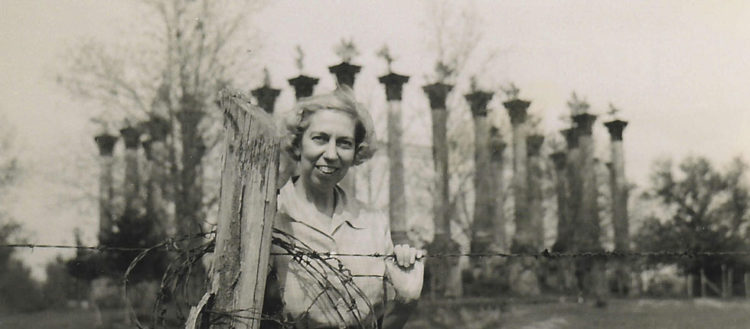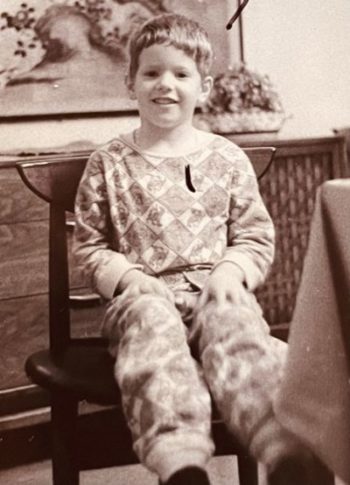
Pulitzer Prize-winning writer Eudora Welty
Quintero was the kind of man who sent himself flowers, and who once climbed the stone steps of a Mayan temple on his knees to atone for sins. He did nothing he did not mean to do. When cancer took his larynx, he learned to speak with a Servox held against his throat. The electronic device mimicked larynx function, but produced an eerie, digital sound, devoid of timbre and pitch. His intense gaze, however, focused and propelled that disembodied voice, and taught me to listen with my eyes.
Our time together taught me how little I knew about directing. He eviscerated my work with devastating tact, but left me with a treasure: a used copy of Eudora Welty’s “One Writer’s Beginnings.” He pressed it into my hand and, in his toneless voice, insisted I read, aloud, what he had inscribed to me.
From one without a voice, to one in search of his own. Listen with your blood. Con mucho cariño, José.
Despite his clear directive, my career progressed like hopscotch. Though trained as a director, I first became an actor. The staccato rhythm of the profession suited my ADHD-challenged attention span. Then I became a director and a teacher, both slightly steadier versions of the same sharp tempo. I wrote monologues and fragments of plays. During that fitful era, I returned to Ms. Welty’s book many times. It became both a talisman and a homing device. Her lucid calm hushed the fretful voice inside that told me over and over again: You should write.
“One Writer’s Beginnings” reads in three parts: “Listening,” “Learning to See,” and “Finding a Voice.” Through each section, Eudora Welty’s alchemy distills generations of experience into gold. She made me think I could — and should — be a writer. All I had to do was listen, learn to see, and find a voice.
That was 31 years ago.
The struggle — and drive — to write

Scott Plate, age 4
For someone with ADHD, listening can be a strain. The designation was new when I was a child, as were medications designed to treat it. I’ve never been formally diagnosed. But all my life, there have been any number of voices inside my head clamoring for attention. To cope, I learned to listen outside myself, and became an expert mimic. I spent decades (poorly) imitating writers whose voices sounded authentic: Gabriel Garcia Marquez’s nuclear intensity, Isabel Allende’s heirloom embroidery, Toni Morrison’s effortless power. Though impressive on its surface, my mimetic ability distracted me from discerning pure tone.
Learning to see with ADHD is like making sense of a kaleidoscope. It became a kind of superpower working in the theater, especially as a director. Physical eye and the mind’s eye vie for supremacy. Shifting patterns dazzle and seduce. Possibility becomes more potent than reality. The visible world distorts, pulled between what you want to see and what is truly there. I learned to invent the truth.
And finding a voice? That felt like an uneasy courtship with a serial shape-shifter. I knew I had one, but had no clue how to distinguish between the impressionist and the source.
Yet writing refused to let me go. It forced me into solitary confinement with myself, and with a core truth: I hungered for my own company.
While on sabbatical from a teaching job, I wrote a story about my father and a dog I convinced him to adopt. I posted it on my blog, and linked it to my Facebook page. Within 72 hours, it had been shared 330,000 times. Then HuffPost republished it in English and in German. I was overwhelmed. I felt like someone out for a leisurely swim who suddenly found himself in the middle of the ocean.
But what I remember most about writing that story was a total absorption in rendering what I’d experienced. For someone who lives within ADHD’s powerful centrifugal force, absorption is a triumph. I remember the love the writer felt, and the sacrifice that love required. I also heard my voice, and I knew it was me.
I’d immersed myself in acting and directing work before, but it never felt like this; while I was writing, I felt alive, generous, loving, and clear.
Then for months I did nothing. I did nothing. I was frightened that what happened had been an accident. That I’d simply been struck by lightning. I could not un-see nor un-hear any of it, but for the life of me, I could not understand what I had done.
The need to understand slowly gave me the courage to discover what it was I appeared to know how to do. But I had no tools.
Finding the right tools
The door to the toolshed opened, at age 54, into a series of classrooms. There, teachers encouraged me to “get to the verb” and examine my writing habits forensically. Reading my work with a gimlet eye felt like camping in the wilderness, opening my gear bag, and wondering who had packed all that evening wear. Compound verbs, subordinate clauses, cluttering adverbs, frequent gerund use, passive voice…my writing choked on mannered complexity. I had no voice of my own.
Ironically, my kaleidoscopic way of seeing helped discern and reassemble these patterns. I started assimilating patterns I instinctively knew were clearer — but I didn’t yet know how to make them clearer on my own. There was still clutter, but my ADHD’s sense of it helped me see it for what it was. Like a recovering hoarder, I finally reached a point where I was overwhelmed with what I had accumulated. I snapped into focus and worked to put words where they belonged, or got rid of them.
The first decluttering tool I learned to use on my own was haiku. Its simplicity was a revelation. Suddenly this dog knew his place in the pack. I wrote hundreds of poems, tapping out syllable patterns with the fingers of my right hand. Economy began to seed itself into the soil. I paired my poetry with abstract nature photographs and remembered how to listen with my eyes. I experimented with missing beats, to see if what I wrote bore any relationship to an unspoken truth, and to see if my words served a purpose at all. Being an actor helped me here. One pillar of spoken text technique is that every uttered word exists in relation to what is silent. We choose each word instead of another. All that is unspoken, however, should be implied. Haiku taught me to provide just enough useful information to guide my reader, but not to do unnecessary work. The form itself invites engagement.

When fall proposes / It gives ev’rything it owns / To winter’s dowry ~ Scott Plate ~
I gained confidence and took a deeper dive into free-verse poetry. This was daunting for someone who typically hid behind clouds of words like a squid eluding prey. I discovered that my predator was the truth. I feared it would reveal the impostor, so I squirted ink and hid. For 31 years I hid behind emails, tenure portfolios, the occasional letter to the editor, and early attempts at plays. What passed for truth was a rule: Everything I wrote needed to be beautiful. Beautiful meant impressive. And impressive meant more. More words, more complexity, more squid ink.
Poetry and haiku encouraged me to venture further into the land of “more,” this time shouldering a rucksack with the essential provisions: economy, precision, and rhythm. The exacting discipline kept me from losing my way. Little by little, I learned to write less, and the fewer words I used, the closer I felt to home. The economy also woke my inner listener, and boy, was he hungry. No wonder – he had subsisted for years on empty carbs.
I remember a six year-old child who couldn’t stop moving or speaking. I remember a child, learning to write, who could not stay within the lines on ruled paper. Who instinctively went to the deepest and scariest part of the cave without a tether, and got lost.
Writing gradually became a way home, where I could rest in who I was.
Embracing the spirals
My ADHD now manifests in circular patterns. When I’m home I can start out by vacuuming, then find myself hanging pictures, then rearranging furniture, only to work my way back to vacuuming, but with a clearer purpose. For me, the returning spiral deepens the groove. It also baffles my husband, who long ago resigned himself to the fact that everything he asks me to do will take longer.
Understanding my spiraling nature finally revealed what drew me to Eudora Welty. She works at the point of confluence, and weaves living strains of experience into a holistic garden of a narrative. José Quintero observed my pastiche directing work, and sensed that Welty’s vortical wizardry might integrate my fragmented attention. He didn’t know it would take as long as it took. Or maybe he did.
Some years ago, I would catch a glimpse of myself whenever I spent time with an 89-year-old friend named Libby Morgan, who also read Eudora Welty. A generous swath of her northern Ohio backyard was a riot of a garden, planted in a serpentine shape. Forty years of her care rendered the soil into a creamy substance you could spread on toast. “Knock some of that stuff off the bottom,” she’d say as I dug up a perennial. “I’m chary with m’ dirt.”
Libby gave me all the starter plants for my first garden in the first home I ever owned. Some of what she shared had come from her grandmother, which meant I had Black-Eyed Susans that could trace their lineage all the way back to the Civil War. I trusted the time it took to become the beauty I held in my hand. As Libby worked in her garden, completely absorbed in what would grow best where, there was nothing else in the world that existed for her at that moment. She’d nestle a plant into the rich dark earth, and say, “Now that must feel good. Now you rest there.” In my bones, I knew what she meant.
The gift Libby gave me — that Eudora gave me, that José gave me — was more precious even than books or flowers. It was knowing that the painstaking work of seeing and digging and listening and being would make my house a home.
***
Scott Plate lives in Silver City, New Mexico. He has had an award-winning, 40-year career as an actor, director, and teacher. He is the co-founder of Native Heartseed, which provides healing space and guidance for individuals, couples, and communities.
